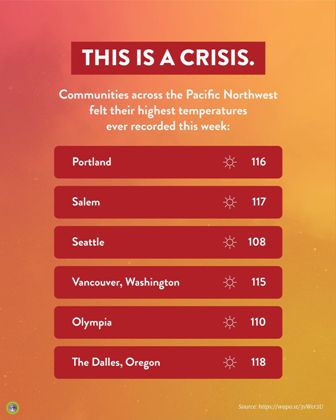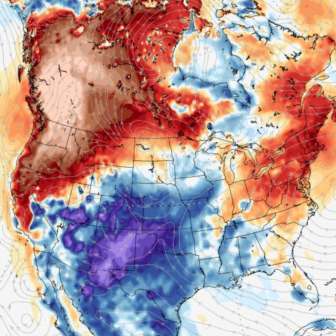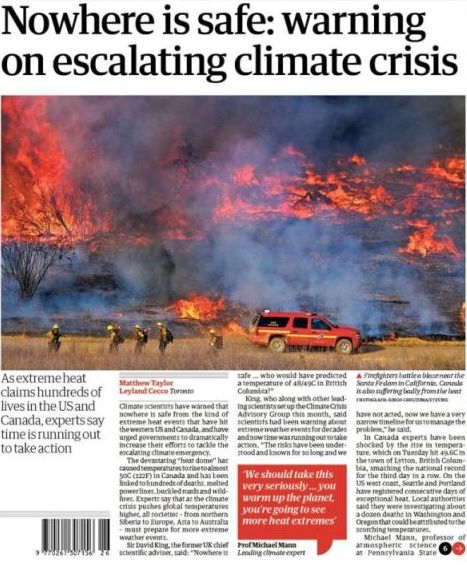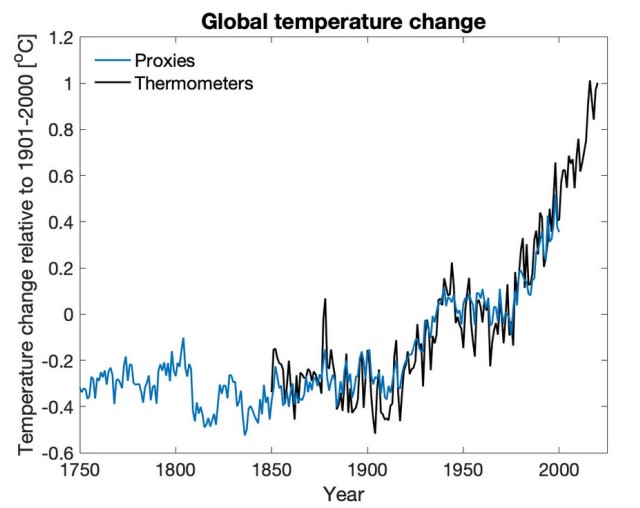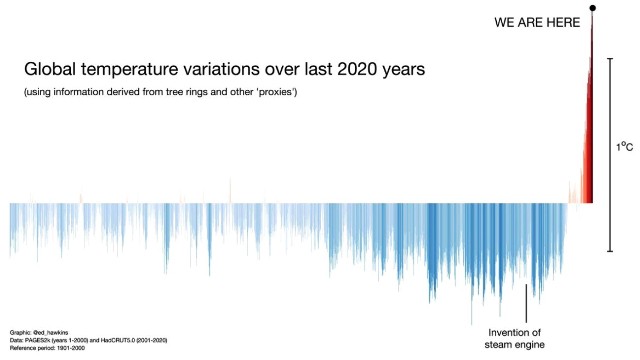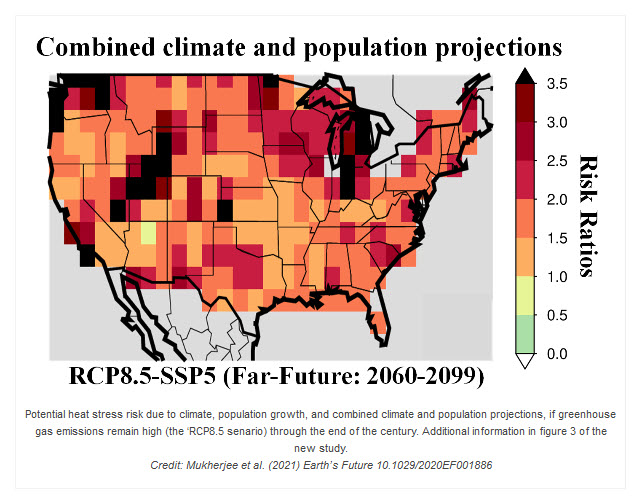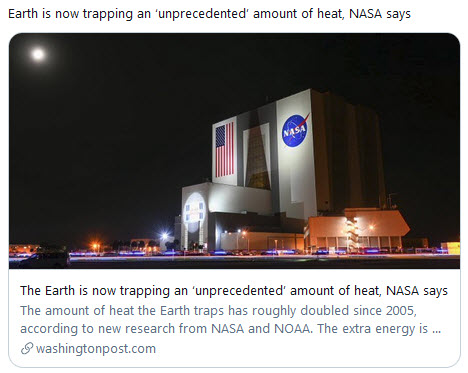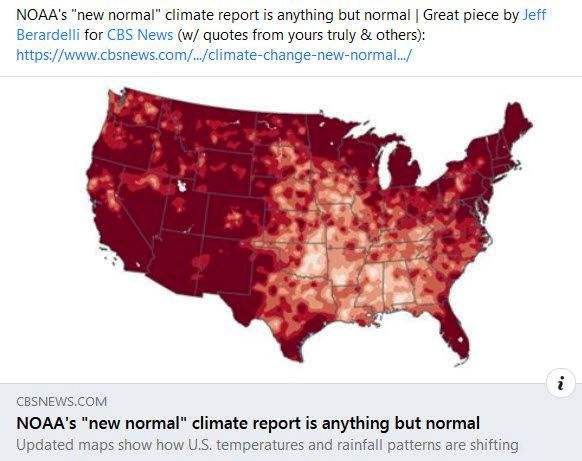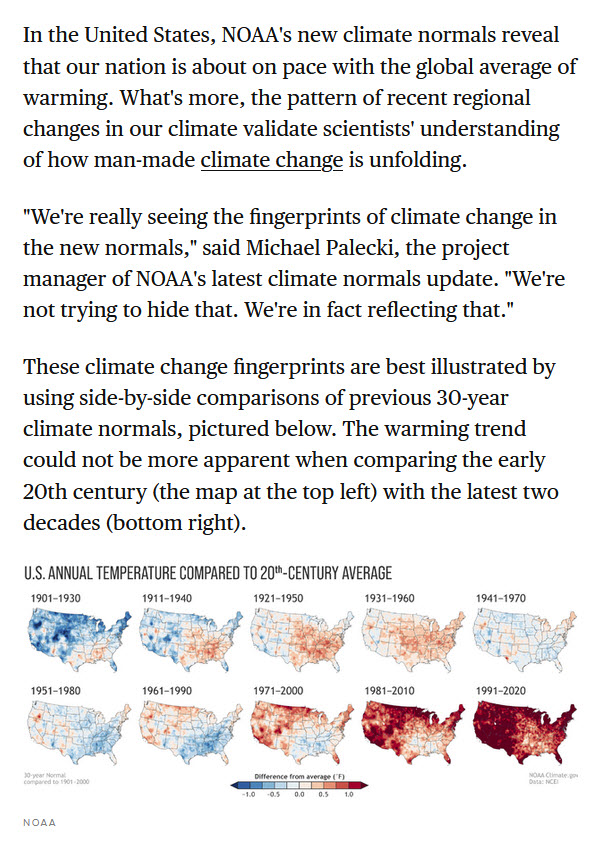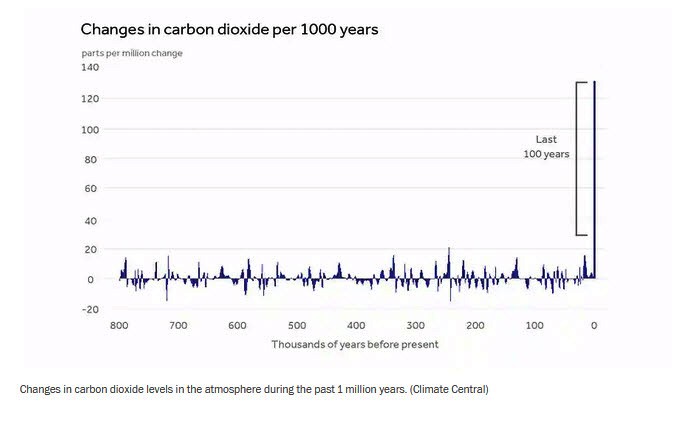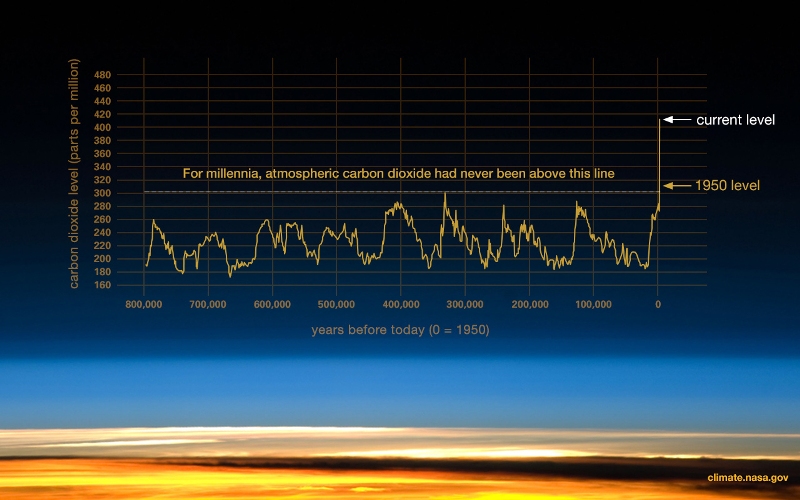Too Hot: Difference between revisions
Siterunner (talk | contribs) No edit summary |
Siterunner (talk | contribs) No edit summary |
||
| Line 100: | Line 100: | ||
Via Climate.gov | [[File:Nowhere is safe - The Guardian.jpg | link=https://www.theguardian.com/environment/2021/jul/01/nowhere-is-safe-say-scientists-as-extreme-heat-causes-chaos-in-us-and-canada]] | ||
| |||
'''Via Climate.gov''' | |||
From Portland, Oregon, to Vancouver, Canada, the heat during the end of June didn't just break records; it buried them. Learn more in this Event Tracker post. | From Portland, Oregon, to Vancouver, Canada, the heat during the end of June didn't just break records; it buried them. Learn more in this Event Tracker post. | ||
| Line 179: | Line 184: | ||
:June 29, 2021 | :June 29, 2021 | ||
* https://www.washingtonpost.com/weather/2021/06/29/heat-wave-pacific-northwest-cause/ | |||
○ | |||
Revision as of 21:53, 2 July 2021
🥵 When it gets too hot....
July 2021
Warning Flashes for Europe: Climate Change Will Heat the Continent
During the heat wave of 2003, European cities cooked their people. It was the hottest August in at least half a millennium, temperatures in the high 30s squatted over much of the continent for weeks. The EU estimates that something like 80,000 people died. French President Jacques Chirac attended a somber burial service for 57 people whose bodies were never claimed.
Under any future warming scenario, a summer like 2003 will be disturbingly normal. According to EU research, at 1.5 degrees of warming, around one in every five people in the EU and U.K. will experience similar heat in any given year. At 3 degrees, that rises to more than half the population.
The heat is literally maddening. Italian researchers found a strong link between psychiatric emergencies and daily temperature. Suicides doubled in Moscow during a heat wave in 2010. In Madrid, incidents of domestic violence and women being murdered by their partners jump when the temperature goes over 34 degrees. Hot nights bring climate insomnia.
We aren’t helping ourselves. An increasing share of Europeans have made their homes in giant, heat-concentrating concrete crucibles. Cities are typically 5 to 10 degrees warmer than the surrounding countryside. If little is done to reduce global emissions, Europe’s cities could warm 6 to 10 degrees on top of that. The south will see the greatest increases. In Rome and other Mediterranean cities, the heat will become so intense that traditional architectural systems relying on natural ventilation will no longer function.
It’s bad timing for an experiment in heat endurance. Not only are millions migrating from rural areas into cement cities; Europe is also getting older and more vulnerable. Better medicine and falling birth rates mean the number of Europeans older than 65 is expected to rise by around 40 million by 2050, even as the overall population slowly declines.
The elderly are at high risk of dying from heat stress and heatstroke. Old bodies also get worn down by heat, making them more susceptible to asthma or cardiovascular and respiratory diseases. Hot days see spikes in hospitalizations for age-related complaints. Aging populations are also more likely to be diabetic; heat causes blood vessels to dilate, absorbing insulin and dragging down blood sugar.
The world has barely warmed by more than 1 degree. But in 2010, the heat killed 54,000 in Russia and Central Europe. Eight years later, during a brutal heat wave that climate change made five times more likely, 104,000 died — the most in any region of the world that year. Germany alone recorded around two-thirds of the heat-related deaths of India, the Lancet medical journal reported, despite having a population 16 times smaller.
At these lower temperature increases, deaths are concentrated in Southern and Central Europe. If warming reaches 3 degrees, 200 million Europeans, not only in the south, but many in the north and the U.K., will live at high risk of heat stress. Without rapid changes to the built environment, the EU says extreme heat could kill 95,000 Europeans every year — more than 30 times the current average rate.
Of course, there are things we can do. The immediate answer is air conditioning. But that brings its own problems. Energy use for cooling buildings in the Mediterranean — already a big source of carbon emissions — will double by 2035. In Southern Europe a new cooling poverty gap is already opening up between those who can afford to beat the heat and those who can’t.
Europe is destined to become a hot continent. Even though Northern Europeans face less steep temperature increases, they need to start thinking like southerners. Buildings designed to trap heat in winter do the same in summer. It costs four times as much to build passive cooling into an existing home than it does to fit it to a new build, according to the U.K.’s Committee on Climate Change. To cope, the streets of London, Copenhagen and Brussels will need to acquire the romantic, eyelidded feel that heavy wooden shutters bring to Rome and Marseille or the utilitarian look of roller blinds in Athens, Seville or Naples...
·························································
The "Wet Bulb" Temperature
"Wet bulb" temperature is the temperature + relative humidity at which water stops evaporating off a "wet" thermometer bulb. If air is sufficiently humid (saturated w/ water vapor), evaporation will no longer cool the bulb, and it gets continuously hotter.
This matters for humans, because our bodies regulate heat via evaporation: sweat glands carry heat from body to the skin surface, where it evaporates, dissipating heat into the air. As long as you stay hydrated (and take salts! salt is important), you can stay cool at high temps.
However, a key interaction here is evaporation, which is controlled in part by a) amount of energy in the sweat (how much heat it is carrying) and b) how much moisture is already in the air.
Wet bulb takes a minute to grok because it's not about *heat,* per se. It's about the absorptive capacity of air. A wet bulb temperature in the mid-80s F can, and does, kill humans.
While body temp is ~97-99 F, we maintain temp by sweating. If sweat won't evaporate, our body temp rises, continuously. And when body temp hits ~108, we're dead.
For a vulnerable person in wet bulb temp, this takes much less than an hour.
(Side note: Weather forecasters should announce the wet bulb temperature or Human Heat Index as a matter of public service)
So, what does this have to do with you? Well, up until last ~ 40 years, wet bulb temperatures were *extremely rare* on this planet.
But that's over, now. We're already seeing multiple wet bulb temperatures per year in multiple locations. By mid-century, parts of the Southeastern U.S will see *weeks* of wet bulbs *every year.*
This is quite bad. Thousands of people will die on each of those days.
Dangerous humid heat extremes occurring decades before expected
Oppressively hot summer days often evoke the expression, “it’s not the heat, it’s the humidity.” That sticky, tropical-like air combined with high temperatures is more than unpleasant — it makes extreme heat a greater health risk.
Climate models project that combinations of heat and humidity could reach deadly thresholds for anyone spending several hours outdoors by the end of the 21st century. However, new research says these extremes are already happening — decades before anticipated — due to global warming to date.
The emergence of heat and humidity too severe for human tolerance
June 2021
Via The Guardian
Via Climate.gov
From Portland, Oregon, to Vancouver, Canada, the heat during the end of June didn't just break records; it buried them. Learn more in this Event Tracker post.
Astounding heat obliterates all-time records across the Pacific Northwest and Western Canada
Devastating News: Climate Change Impacts to Hit Sooner than Predicted
Climate change will fundamentally reshape life on Earth in the coming decades, even if humans can tame planet-warming greenhouse gas emissions...
Via landmark draft report from the UN's climate science advisors obtained by AFP
Earth is now trapping an ‘unprecedented’ amount of heat, NASA says
New research shows that the amount of heat the planet traps has roughly doubled since 2005, contributing to more rapidly warming oceans, air and land
The amount of heat Earth traps has roughly doubled since 2005, contributing to more rapidly warming oceans, air and land, according to new research from NASA and the National Oceanic and Atmospheric Administration (NOAA).
“The magnitude of the increase is unprecedented,” said Norman Loeb, a NASA scientist and lead author of the study, which was published this week in the journal Geophysical Research Letters. “The Earth is warming faster than expected.”
Using satellite data, researchers measured what is known as Earth’s energy imbalance — the difference between how much energy the planet absorbs from the sun, and how much it’s able to shed, or radiate back out into space.
When there is a positive imbalance — Earth absorbing more heat than it is losing — it is a first step toward global warming, said Stuart Evans, a climate scientist at the University at Buffalo. “It’s a sign the Earth is gaining energy.”
·························································
From Clearwater, Florida, May 2021
GreenPolicy360 Siterunner/SJS:
Trendlines, we are looking at trendlines today. Data, the data changing as time passes. We need to step back and have perspective. We need to look closely, to 'drill down' and see with detail. Measure-to-Manage NASA says, science advises, GreenPolicy360 recommends as a guide.
GreenPolicy360 believes in personal responsibility to manage wisely. We are planet citizens and earth is in human hands. Together we are guiding our planet home into the future. We are delivering a legacy to future generations.
Join planet citizens who are monitoring our Earth's 'Vital Signs'.
One of GreenPolicy360's great concerns is climate change, as all our readers and sharers know. A recent study of a 'new normal' caught our attention today, a global study and national breakout of data changing over time. And as we are looking at this 'new normal' data, a century of temperatures, we cannot help but think what will happen if the temperature increases continue, a trendline into the future, up and up into the 'unliveable... uninhabitable' temperatures range. 'Cooling technology' will be required and being outdoors will be limited...
Let's look more closely, a recent news 'wrap up' from a science reporter for the Associated Press.
Look .... recognize the threats. Act planet citizens, act ....
- Via the Washington Post
- Unprecedented Heatwave in the U.S. Pacific Northwest
- June 29, 2021
○
Record heat bakes Middle East as temperatures top 125 degrees
It has been called ‘the harshest heat wave in history for this time of the year’
June 9, 2021
Via the Boston Globe
Ninety degree days occurring earlier and more often. A rising toll of health effects
What does this say about climate change?
June 7, 2021
Via the Associated Press
Billions projected to suffer nearly unlivable heat in 2070
By Seth Borenstein
May 4, 2020
(AP) — In just 50 years, 2 billion to 3.5 billion people, mostly the poor who can’t afford air conditioning, will be living in a climate that historically has been too hot to handle, a new study said.
With every 1.8 degree (1 degree Celsius) increase in global average annual temperature from man-made climate change, about a billion or so people will end up in areas too warm day-in, day-out to be habitable without cooling technology, according to ecologist Marten Scheffer of Wageningen University in the Netherlands.
'How many people will end up at risk depends on how much heat-trapping carbon dioxide emissions are reduced and how fast the world population grows.
Under the worst-case scenarios for population growth and for carbon pollution — which many climate scientists say is looking less likely these days — the study in Monday’s journal Proceedings of the National Academy of Sciences predicts about 3.5 billion people will live in extremely hot areas. That’s a third of the projected 2070 population.
············································································································································
GreenPolicy360 / Reporting from our terrestrial home base, Clearwater, Florida, USA:
As just one of multiple examples of what's coming with climate change and global warming, life in Florida, USA is going to be a quite a different experience in the not too distant future. Semi-tropical will become tropical. Then there's the water... not to cool off, but to deal with the consequences of heat...
Florida 13,576 km coastline is at the frontlines of global sea-level rise. Florida is, as few realize is also 'on top of water', situated on a peninsula of 'karst', an ancient seabed of porous limestone. Above the underground water exchange of fresh-and-seawater is a political brew. Florida today, unfortunately, has become chock full of climate-change denying politicos. The state's former governor, now a US Senator, denies climate change is a serious problem, closing his eyes and ears to policy preparation and action as he was reported forbidding state government officials from even using the term 'climate change' .... Florida's following governor, fortunately, is not as extreme in his views and signed a first-ever piece of legislation to establish a state climate-related resiliency program. So there... as of May 2021, signs of environmental protection and progress in the so-called "Sunshine State".
GreenPolicy360 will continue to do what we can to push Florida to become forward-looking. Perhaps a quick look at sea-level rise would be a place to start the new "Too Hot" GreenPolicy360 page.
-- SJS / May 13, 2021
May 2021
Miami gets a "Chief Heat Officer"
by Craig Pittman / Via the Washington Post
Jane Gilbert, the city’s new chief heat officer, says she will put together a task force of experts to address the problem
Last June, Miami reported its hottest temperatures on record. The daytime sun was brutal and there was little respite even at night. Dozens of heat-related deaths were reported that year.
As the Earth warms, the city by the ocean says its heat problem is poised to become even deadlier.
Miami-Dade County Mayor Daniella Levine Cava (D) recently announced the county was creating a first-of-its-kind position — chief heat officer.
“We know extreme heat does not impact people equally — poorer communities and Black and Hispanic people bear the brunt of the public health impacts,” the mayor said in a statement. A chief heat officer will “coordinate our efforts to protect people from heat and save lives.”
Q: But heat is such a fact of life in Miami. What makes that deserving of a chief officer?
A: Miami knows heat — we’re hot and humid a good part of the year. A heat index of 105 degrees is about when you’ve hit dangerous levels, when people could really suffer from heatstroke.
We currently have an average of seven days where we get over that heat index for a couple of hours. By mid-century, we’re going to have 88 of those days — that’s more than 10 times as many days....
Q: How can you answer someone who challenges the existence of climate change?
A: We don’t have many of them in Miami-Dade County.
I’ve felt the change in the heat in the 26 years I’ve been here. It’s hard to argue that heat can’t be a risk when you’ve seen people die. It’s the number one climate- and weather-related killer in the United States.
Read Craig's Full Interview with Jane Gilbert
··································································
NOAA's "new normal" climate report is anything but normal
By Jeff Berardelli
May 8, 2021 / 7:11 AM / CBS News
It doesn't take a climate scientist to see the changes that have occurred. In the maps below, using NOAA data, Climate Central illustrates the warmer temperatures the U.S. has experienced. When comparing the latest "normals" to what used to be normal a century ago, the difference is clear — seen in red from coast to coast...
Some climate scientists, like Michael Mann of Penn State, don't love the system of reporting new normals. As he told The Associated Press, Mann prefers using a constant baseline because updating what is normal for present-day conditions obscures the long-term warming trend and makes the warming due to climate change seem less significant. "Adjusting normal every 10 years perverts the meaning of 'normal' and 'normalizes' away climate change."
US Climate Normals
The U.S. Climate Normals are a large suite of data products that provide information about typical climate conditions for thousands of locations across the United States. Normals act both as a ruler to compare today’s weather and tomorrow’s forecast, and as a predictor of conditions in the near future. The official normals are calculated for a uniform 30 year period, and consist of annual/seasonal, monthly, daily, and hourly averages and statistics of temperature, precipitation, and other climatological variables from almost 15,000 U.S. weather stations.
National Centers for Environmental Information (NCEI) generates the official U.S. normals every 10 years in keeping with the needs of our user community and the requirements of the World Meteorological Organization (WMO) and National Weather Service (NWS). The 1991–2020 U.S. Climate Normals are the latest in a series of decadal normals first produced in the 1950s. These data allow travelers to pack the right clothes, farmers to plant the best crop varieties, and utilities to plan for seasonal energy usage. Many other important economic decisions that are made beyond the predictive range of standard weather forecasts are either based on or influenced by climate normals.
🌎
Future of the Human Climate Niche
Proceedings of the National Academy of Sciences of the U.S.
May 26, 2020
Significance
We show that for thousands of years, humans have concentrated in a surprisingly narrow subset of Earth’s available climates, characterized by mean annual temperatures around ∼13 °C. This distribution likely reflects a human temperature niche related to fundamental constraints. We demonstrate that depending on scenarios of population growth and warming, over the coming 50 y, 1 to 3 billion people are projected to be left outside the climate conditions that have served humanity well over the past 6,000 y. Absent climate mitigation or migration, a substantial part of humanity will be exposed to mean annual temperatures warmer than nearly anywhere today.
Abstract
All species have an environmental niche, and despite technological advances, humans are unlikely to be an exception. Here, we demonstrate that for millennia, human populations have resided in the same narrow part of the climatic envelope available on the globe, characterized by a major mode around ∼11 °C to 15 °C mean annual temperature (MAT). Supporting the fundamental nature of this temperature niche, current production of crops and livestock is largely limited to the same conditions, and the same optimum has been found for agricultural and nonagricultural economic output of countries through analyses of year-to-year variation. We show that in a business-as-usual climate change scenario, the geographical position of this temperature niche is projected to shift more over the coming 50 y than it has moved since 6000 BP. Populations will not simply track the shifting climate, as adaptation in situ may address some of the challenges, and many other factors affect decisions to migrate. Nevertheless, in the absence of migration, one third of the global population is projected to experience a MAT >29 °C currently found in only 0.8% of the Earth’s land surface, mostly concentrated in the Sahara. As the potentially most affected regions are among the poorest in the world, where adaptive capacity is low, enhancing human development in those areas should be a priority alongside climate mitigation.
April 2021
Heat Stress (HS) in Earth's Future
Fastest Warming Cities and States in the U.S.
- 2019
~
- Air Quality
- Air Pollution
- Agriculture
- Alternative Agriculture
- Antarctica
- Anthropocene
- Arctic
- Atmospheric Science
- Citizen Science
- City Governments
- Climate Change
- Climate Migration
- Climate Policy
- County Governments
- Desertification
- Digital Citizen
- Earth Imaging
- Earth Observations
- Earth360
- Earth Science
- Earth Science from Space
- Earth System Science
- Ecology Studies
- Eco-nomics
- Economic Justice
- Education
- Energy
- Environmental Laws
- Environmental Protection
- Environmental Security
- Environmental Security, National Security
- ESA
- European Union
- Externalities
- Extinction
- Florida
- Food
- Forests
- Fossil Fuels
- Greenland
- Global Security
- Global Warming
- Green Networking
- Green Best Practices
- Green Politics
- Health
- INDC
- Maps
- Money in Politics
- NASA
- NOAA
- Natural Resources
- Networking
- New Definitions of National Security
- New Economy
- New Space
- Oceans
- Ocean Science
- Online Education
- Planet Citizen
- Planet Citizens
- Planet Citizens, Planet Scientists
- Rainforest
- Renewable Energy
- Resilience
- Sea-level Rise
- Sea-Level Rise & Mitigation
- Social Justice
- Soil
- Solar Energy
- Strategic Demands
- Sustainability Policies
- Threat Multiplier
- United Nations
- US
- US Environmental Protection Agency
- Water Quality
- Whole Earth
- Wind Energy
- World Bank
- World Wide Web
- Youth
